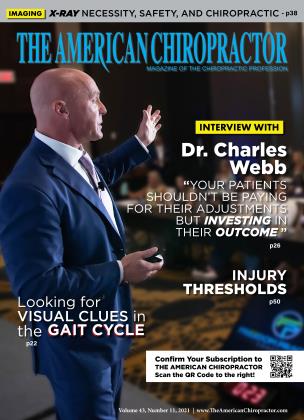In a recent paper by Freedman et al., the authors wrote, “Traffic injury claims after minimaldamage crashes make up a substantial portion of civil litigation. A major point of contention in such litigation is injury causation, with claimants most commonly relying on the opinion of a treating clinician to establish the crash as the cause of persisting injury.” (p. 1)
The authors continued by stating, “Insurer defendants often rely on an engineering or ‘biomechanical approach’ as a basis for denying the causal nexus between the crash and the claimed injuries.” (p. 1) In terms of the process of the biomechanical approach, the authors wrote, “The approach most commonly utilizes a sequential multistep process first, the collision is reconstructed for severity, quantified by the speed change or ‘delta V’ (DV) of the crash. Next, the reconstructed delta V is compared to experimental volunteer crash test studies, and the occupant accelerations from the studies (g-forces) are assigned to the investigated crash. Finally, the occupant forces attributed to the crash via the first two steps are compared to the forces described in studies of activities of daily living (ADLs), which allows for the conclusion that the risk of injury from the investigated crash was the same as the risk of injury from ADLs.” (p. 1)
The study went on to state, “By design, the defendant’s biomechanical causation approach will always result in the same conclusion; that a minimal-damage crash was no more likely to cause a medically observed injury than forces encountered when walking or running, sitting down in a chair, head nodding, or by sneezing, etc. The conclusion is at odds with the results of large epidemiologic studies that indicate an injury rate of more than 20% in minimaland no-damage crashes, and that such crashes result in several hundred thousand injuries diagnosed in U.S. emergency departments annually.” (p. 2) We can see very clearly in this paper that the biomechanical approach is not consistent with population-based studies and certainly not in line with what healthcare providers see in their clinics.
The authors continued, “A fundamental operating premise of the biomechanical causation approach is that acceleration is a valid proxy for injury risk, and thus the evidence that the occupant acceleration of a crash is the same as the acceleration of an ADL translates to evidence that the risk of the injury from the two different events also the same. This is a unique approach to estimating risk, and one that does not exist outside of the defense of injury litigation.” (p. 3) This is interesting since the process by which the defense’s biomechanical approach is designed around is unique to the litigation world, making it an outlier in terms of the rest of science.
The authors then reported, “Further, the basic rationale underlying the first step of the biomechanical causation approach (reconstruction of the crash severity), which is that delta V is a reliable predictor of injury risk, has been called into question by the results of a recent longitudinal study of crash-related injuries, which reported that reconstructed crash severity is unrelated to the risk of developing chronic symptoms” (p. 2)
Additionally, they stated, “Our analysis demonstrates that the theoretical basis for the biomechanical injury causation approach is scientifically invalid. As described in Section 3.4 above, the theory that serves as the operating principle for the methodology, that acceleration is a proxy for injury risk in low-speed or minimal-damage crashes, is demonstrably false. Even at the lowest levels of impact severity in a rear-impact crash, the results of both crash testing and epidemiologic data from real-world crashes indicate a substantial (i.e., >20%) risk of at least some degree of injury.” (p. 12)
In conclusion, they stated, “Our results indicate that there is an enormous disparity between the risk of injury from ADLs and minimal-damage crashes, and that the former cannot be used as a proxy for the latter. While the upper bound of the peak head accelerations observed for some ADLs overlap with the lower bound of peak head accelerations observed in some no-damage rearimpact crash tests, the risk of injury from most minimaldamage crashes (at least 20%) is thousands of times greater than for any ADL. These results demonstrate that the biomechanical approach utilized in the legal defense of injury claims, in which the injury risk of a minimaldamage rear-impact crash is deemed comparable to the injury risk of ADLs, is an invalid method for evaluating injury causation. The approach should be discontinued, or in the alternative, ruled inadmissible by courts as its use results in unreliable expert testimony.” (p. 15)
Reference
1. Nolet, P S., Nordhoff, L., Kristman, V L., Croft, A. C., Zeegers, M. R, & Freeman, M. D. (2021). Is Acceleration a Valid Proxy for Injury Risk in Minimal Damage Traffic Crashes? A Comparative Review of Volunteer, ADL and Real-World Studies. International Journal of Environmental Research and Public Health, 18(6), 2901.
Dr William Owens Jr is currently in private practice in Buffalo, NY. His practice employees 4 Doctors of Chiropractic and 2 Physical Therapists. He is President and CEO of the National Spine Management Group, LLC and Clinical Director of the Fellowship in Spinal Biomechanics and Trauma. Additionally, Dr. Owens is Adjunct Faculty in Family Medicine at the State University of New York at Buffalo Jacobs School of Medicine and Cleveland University Kansas City, College of Chiropractic. He can be reached at 716.228.3847.
 View Full Issue
View Full Issue












